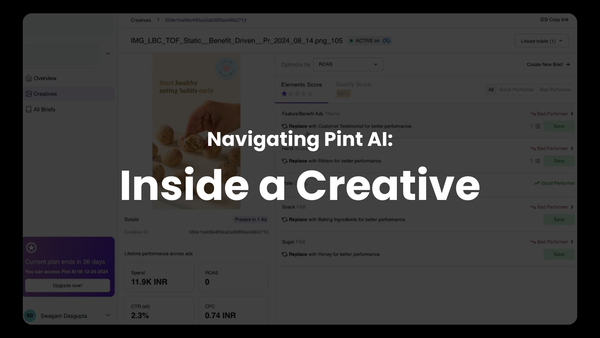WTF Is Dynamic Creative Optimization (DCO)?
DCO claims to make advertiser's lives easier. But what exactly is it and how does it work?

Over the past few years, Meta has consistently rolled out features to its ad systems, to help advertisers get better results. One such feature was the addition of Dynamic Creatives.
Introducing Dynamic Creatives
Released in 2017, dynamic creatives are a feature of ads that allows for the automatic combination and testing of different ad elements to create multiple variations of an advertisement. Basically, you can upload a number of images, videos and text combinations, and Facebook will automatically put them together in different combinations and place them for your target audience, to get the best results.

How Dynamic Creatives Aid Creative Testing
Dynamic creatives also allow for extensive, in-depth testing. Here's how:
- Automated A/B Testing: Once the ad variations are created, they are tested across different audience segments. This prcoess is automated, meaning Facebook uses its algorithms to determine which segment of the audience sees which ad variation.
- Audience Segmentation: Audiences can be segmented based on demographics, interests, behavior, or other criteria defined by you and what Facebook allows. The thesis here is that each segment may respond differently to different ad elements.
- Performance Analysis: The system tracks how each ad variation performs with each audience segment. Performance metrics include click-through rates, conversion rates, engagement rates, etc.
- Data-Driven Adjustments: Facebook then adjusts which variations are shown based on real-time performance data. This means that if a particular combination of headline and image is performing well with a certain demographic, the system will show that combination more often to similar users.
Dynamic Creative Optimization for Best Results
The optimization process in dynamic creatives involves refining the ad delivery to maximize effectiveness. The best part? Facebook's algorithms take care of it all:
- Prioritizing Best Performers: As the campaign progresses, the system identifies the best performing ad combinations. These top-performers are then shown more frequently.
- Real-Time Optimization: This optimization is exactly how it sounds—it happens in real-time. The system constantly evaluates the performance of each ad variation and adjusts its delivery accordingly. If a certain combination starts performing better, it will automatically prioritize that. This significantly reduces (and in fact, eliminates!) manual intervention.
- Balancing Exploration and Execution: Initially, there might be a more exploratory phase where the system tests various combinations more broadly. As it starts gathering data on what works, it automatically shifts towards identifying and pushing out the best-performing variations.
- Learning and Evolving: The algorithms learns not just which individual elements (like a specific image or headline) work best, but which combinations of elements are most effective. This learning is not static; it evolves as audience responses and external factors change over time.
DCO's Impact: Case Studies
Hunch, a creative technology company for social commerce marketing compiled some of their successes with DCO, and the results are worth a look:
- 58% Increase in Return on Ad Spend (ROAS): In a case study involving a fresh food retailer, Ametller, and the Spanish creative production agency FEEDB<CK, the use of DCO led to a 58% ROAS uplift. This demonstrates DCO’s potential in driving not just engagement or clicks, but actual financial returns.
- Reduction in Cost Per Acquisition (CPA) by 18% & 58%: A major client of Paragone—an enterprise growth marketing platfrom—using DCO, achieved significant reductions in CPA in different markets. For one market, the CPA was reduced by as much as 58%, and another prominent market saw an 18% reduction in CPA. This showcases DCO's ability to optimize ad spend and improve the efficiency of ad campaigns.
- 67% Rise in ROI for Jewelry Brand: Finally, Roma, a US-based jewelry brand, demonstrated the power of DCO in conjunction with automated creative production. This approach led to an increase in their ROAS by 120% for their bottom-of-the-funnel retargeting, and a 67% rise in overall ROI.
Takeaway and Further Resources
All in all, DCO really makes life much easier for advertisers. While there is a loss in terms of total creative control of making the variations, this can be controlled for, by ensuring the images, videos and text given to the system are high in quality in and of themselves. When this is achieved, the system can provide the best results for you.
Learning from past experiences, Meta will keep tinkering with its systems to provide the ideal best scenarios for advertisers. Their recent Advantage+ shopping campaigns are proof of this. The best that we as advertisers can do, is really scrutinize and understand the creative elements that will resonate. It's there that you can hope to strike gold.
Here are some further resources about DCO:
- Facebook Dynamic Creative Ads - Should You Use Them? (Dynamic Creatives vs. Standard Ads)
- Dynamic Creative Optimization guide for Meta: Run better ads on Facebook and Instagram
- How Facebook Dynamic Creative Optimization (DCO) could be your best friend
For more such content, subscribe to Analyze That Ad today, and follow us on X (formerly Twitter)!





